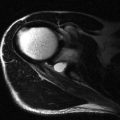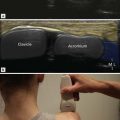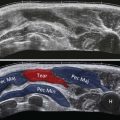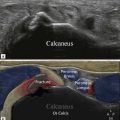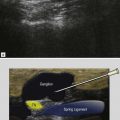Tendon Disease
Extensor Carpi Ulnaris Instability
The extensor carpi ulnaris (ECU) tendon passes through the sixth extensor compartment, a fibroosseous tunnel over the distal 2 cm of the ulna.
The ECU subsheath is a retinaculum, separate from the extensor retinaculum, which keeps the ECU tendon in the correct position during rotation, flexion and extension of the wrist.
Tears of the subsheath are the result of acute trauma, chronic overuse or inflammatory changes of the ECU tendon sheath, such as in rheumatoid arthritis. ECU instability typically occurs in professional tennis and golf players. Repeated sudden forceful pronation of the forearm from a supinated position, such as during a tennis serve, results in sudden contraction of the ECU tendon and stripping of the ventral attachment of the retinaculum from the ulna. This results in anterior (volar) subluxation or dislocation of the ECU tendon. Patients typically present with painful snapping over the ulnar aspect of the wrist with forearm rotation. ECU instability is also observed in patients with long-standing rheumatoid arthritis causing ECU tenosynovitis and distal radioulnar joint disease. Pannus disrupts the retinaculum and the ECU tendon tends to migrate to the volar surface of the ulna and behaves like a wrist flexor rather than an extensor, causing dislocation of the distal ulna relative to the radius.
Ultrasound is ideal to demonstrate the status of the tendon and its position relative to the ulnar groove at rest and during stressing. Some displacement is to be expected in asymptomatic subjects. In a study using a percentage of the width of the ulnar groove, the ECU tendon was seen to displace by up to 40% beyond the volar lip of the ulnar groove with wrist flexion. In a second study using a percentage of displacement relative to the apex of the ulnar border of the ulnar groove, the ECU tendon was observed to displace by up to 50% (or 5 mm) volar to the ulnar border of the groove with forearm supination or wrist ulnar deviation, and by up to 45% with wrist flexion.
In symptomatic subjects, the ECU tendon may be seen to sublux along the ulnar border of the ulnar groove with a flattened appearance as a result of tensile forces applied on it. In more severe cases, the tendon intermittently dislocates over the ulnar border and out of the groove.
| Dynamic scanning of ECU in short axis is used to demonstrate volar subluxation of the tendon with forearm supination and wrist flexion ( Fig. 12.1 ). |
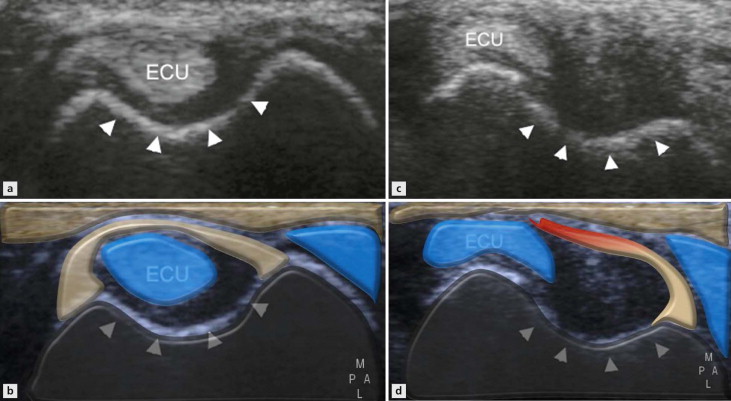
Permanent dislocation of the tendon is uncommon and is best seen in the transverse plane over the posteromedial ulna. The ulnar groove is empty and the retinaculum is usually attenuated and irregular.
ECU Tenosynovitis
ECU tenosynovitis is mostly due to mechanical friction of the tendon against the ulna, secondary to instability. Patients present with localized pain over the dorsal medial aspect of the distal ulna and occasionally a snapping sensation if tendon subluxation is present. Ultrasound is valuable to identify a tendon sheath effusion and synovial hypertrophy, associated tendinosis and intratendinous splits ( Fig. 12.2 ), as well as tendon subluxation ( Figs 12.3 and 12.4 ).



Tenosynovitis of Other Extensor Tendon Compartments
All of the extensor compartments (ECs) may be affected by tenosynovitis and tendinopathy, although EC4 and EC5 are least common. EC4 is normally surrounded by a thick retinaculum, much thicker than the other compartments. This should not be misinterpreted as tenosynovitis. True tenosynovitis will fill the compartment unevenly ( Fig. 12.5 ) and may be accompanied by increased Doppler activity in many cases ( Fig. 12.6 ). Furthermore, intrasheath synovitis will result in some separation of the tendons.



Stay updated, free articles. Join our Telegram channel

Full access? Get Clinical Tree



